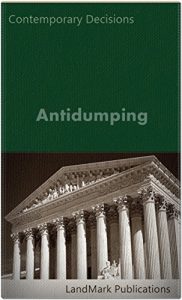THIS CASEBOOK contains a selection of 125 U. S. Court of Appeals decisions that analyze, interpret and apply the rules governing the imposition of antidumping duties. The selection of decisions spans from 2005 to the date of publication.
The antidumping statute authorizes [the U. S. Department of] Commerce to impose duties on imported goods that are sold in the United States at less-than-fair value if it is determined that a domestic industry is "materially injured, or threated with material injury." See 19 U.S.C. § 1673. Once an antidumping duty order covering certain goods is in place, "Commerce periodically reviews and reassesses antidumping duties" during administrative reviews. Gallant Ocean (Thai.) Co. v. United States, 602 F.3d 1319, 1321 (Fed. Cir. 2010) (citing 19 U.S.C. §§ 1673, 1675(a)). Dongtai Peak Honey Industry Co., Ltd. v. US, (Fed. Cir. 2015).
Commerce calculates the antidumping duty using the export price methodology. See Certain Frozen Warmwater Shrimp from India, 76 Fed. Reg. 12025, 12028 (Mar. 4, 2011) (prelim. admin. review, partial rescission, and prelim. determination). Under this method, Commerce determines whether subject merchandise is being sold at less than fair value. If it is, Commerce determines how much less, and then assesses antidumping duties to make up the difference. 19 U.S.C. § 1673. Apex Exports v. US, (Fed. Cir. 2015).
For this calculation, Commerce first determines the "export price" ("EP"). This is the price that the first unaffiliated U.S. buyer pays for the subject merchandise. 19 U.S.C. § 1677a(a) (2012). Then, Commerce calculates the "normal value" ("NV"). This is treated as the fair value, and it is the price at which the subject merchandise is sold in the exporting country. 19 U.S.C. § 1677b(a)(1)(B)(i) (2012). If EP is lower than NV, and it poses a threat to U.S. industry, then Commerce assesses a duty "equal to the amount by which the normal value exceeds the export price." 19 U.S.C. § 1673. In practice, Commerce sets the duty by determining the dumping margin. A weighted average dumping margin is the difference between NV and EP, then divided by EP ((NV — EP)/EP). 19 U.S.C. § 1677(35) (2012). Apex Exports v. US, ibid.
However, it is not quite that simple. The goal of this calculation is to allow Commerce to compare the fair value of the merchandise to the price charged in the U.S. Therefore, both EP and NV are subject to adjustments, so that they closely reflect the price of subject merchandise at a common point in the chain of commerce. 19 U.S.C. § 1677b(a)(1)(B); 19 U.S.C. § 1677a(c)(2); 19 U.S.C. § 1677b(a)(6). Apex Exports v. US, ibid.
. . .
The antidumping statute authorizes [the U. S. Department of] Commerce to impose duties on imported goods that are sold in the United States at less-than-fair value if it is determined that a domestic industry is "materially injured, or threated with material injury." See 19 U.S.C. § 1673. Once an antidumping duty order covering certain goods is in place, "Commerce periodically reviews and reassesses antidumping duties" during administrative reviews. Gallant Ocean (Thai.) Co. v. United States, 602 F.3d 1319, 1321 (Fed. Cir. 2010) (citing 19 U.S.C. §§ 1673, 1675(a)). Dongtai Peak Honey Industry Co., Ltd. v. US, (Fed. Cir. 2015).
Commerce calculates the antidumping duty using the export price methodology. See Certain Frozen Warmwater Shrimp from India, 76 Fed. Reg. 12025, 12028 (Mar. 4, 2011) (prelim. admin. review, partial rescission, and prelim. determination). Under this method, Commerce determines whether subject merchandise is being sold at less than fair value. If it is, Commerce determines how much less, and then assesses antidumping duties to make up the difference. 19 U.S.C. § 1673. Apex Exports v. US, (Fed. Cir. 2015).
For this calculation, Commerce first determines the "export price" ("EP"). This is the price that the first unaffiliated U.S. buyer pays for the subject merchandise. 19 U.S.C. § 1677a(a) (2012). Then, Commerce calculates the "normal value" ("NV"). This is treated as the fair value, and it is the price at which the subject merchandise is sold in the exporting country. 19 U.S.C. § 1677b(a)(1)(B)(i) (2012). If EP is lower than NV, and it poses a threat to U.S. industry, then Commerce assesses a duty "equal to the amount by which the normal value exceeds the export price." 19 U.S.C. § 1673. In practice, Commerce sets the duty by determining the dumping margin. A weighted average dumping margin is the difference between NV and EP, then divided by EP ((NV — EP)/EP). 19 U.S.C. § 1677(35) (2012). Apex Exports v. US, ibid.
However, it is not quite that simple. The goal of this calculation is to allow Commerce to compare the fair value of the merchandise to the price charged in the U.S. Therefore, both EP and NV are subject to adjustments, so that they closely reflect the price of subject merchandise at a common point in the chain of commerce. 19 U.S.C. § 1677b(a)(1)(B); 19 U.S.C. § 1677a(c)(2); 19 U.S.C. § 1677b(a)(6). Apex Exports v. US, ibid.
. . .



